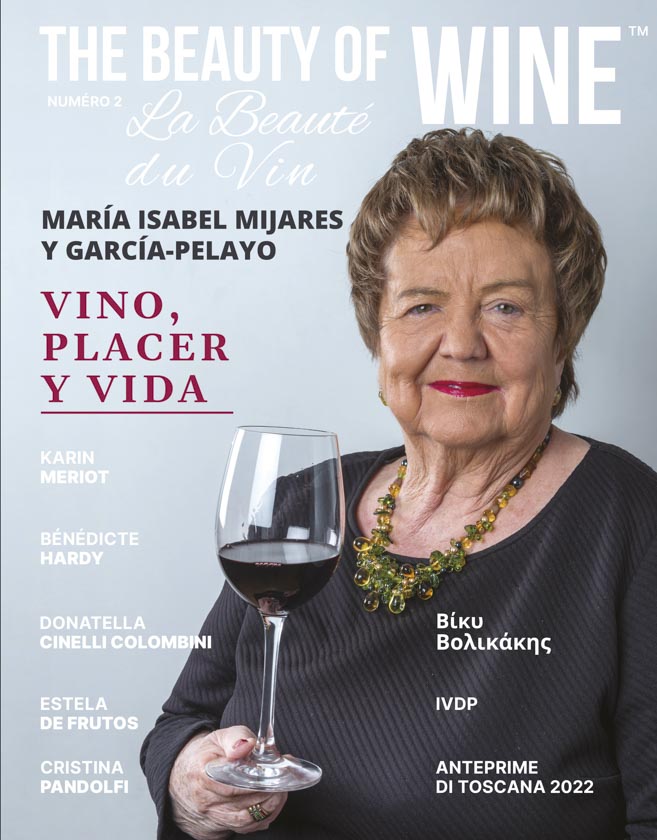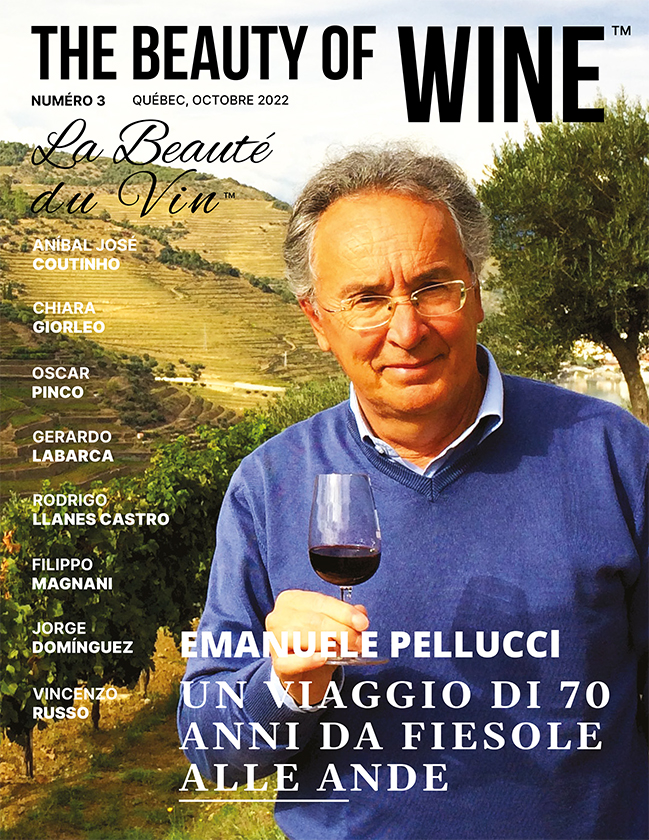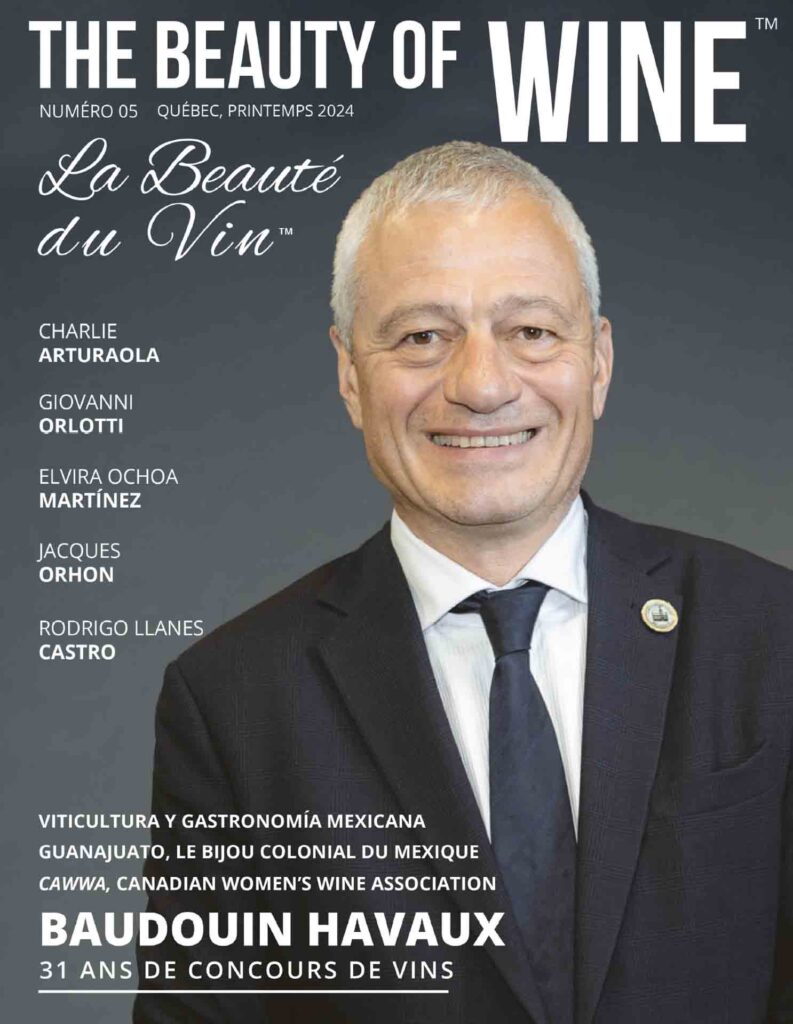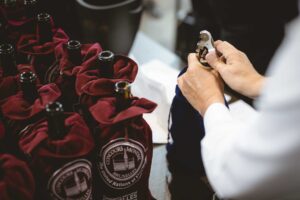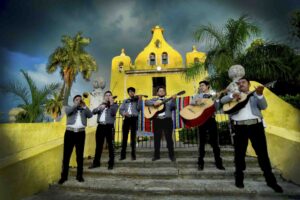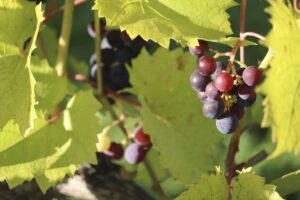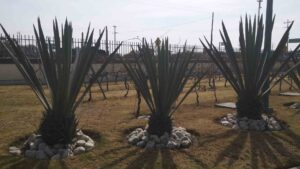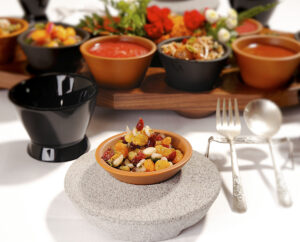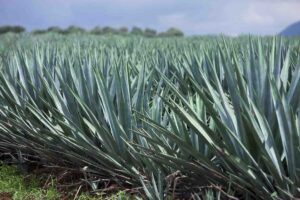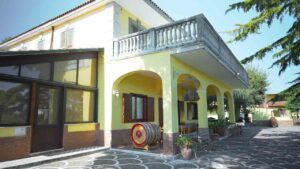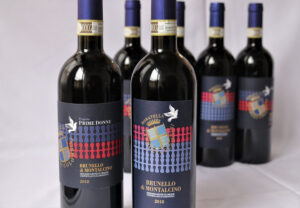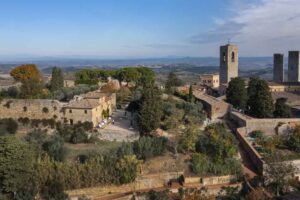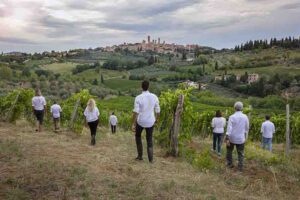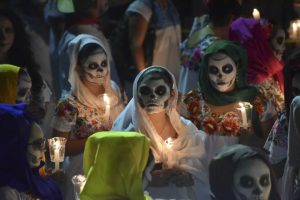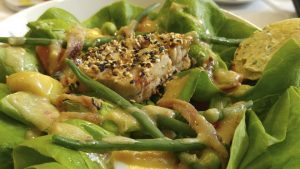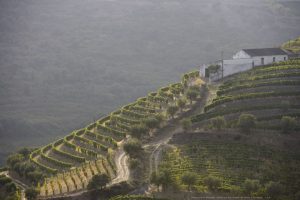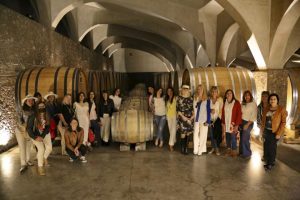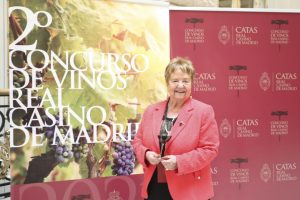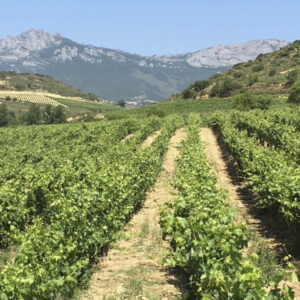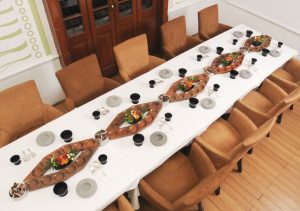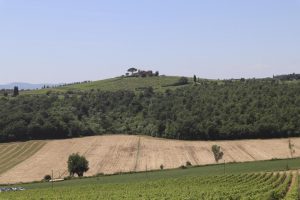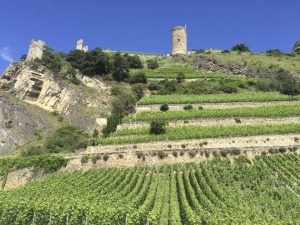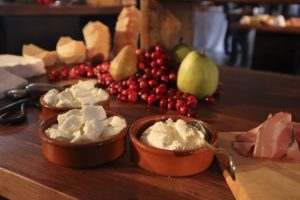Los altares de muertos
**The translation is at the bottom**
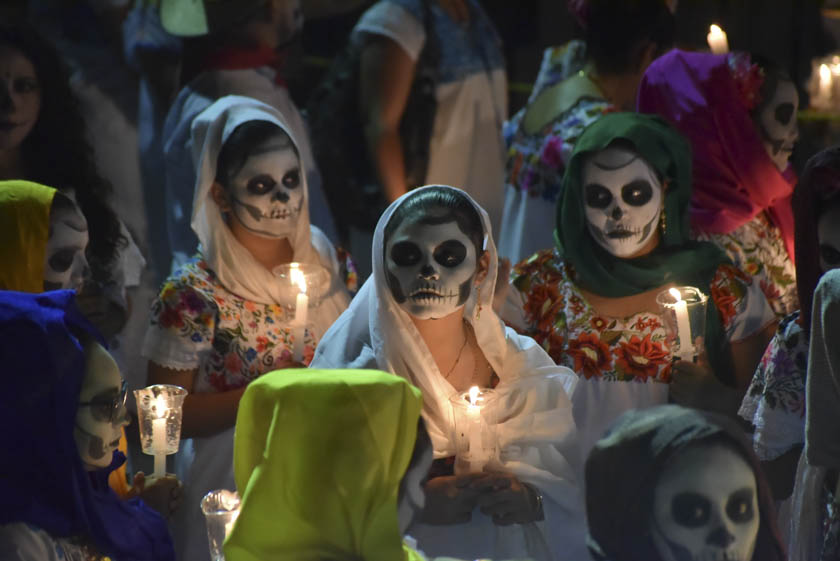
Cada dos de noviembre los mexicanos elaboramos un banquete para nuestros muertos que nos visitan. Así revivimos la expresión mística de la cocina al elaborar los sagrados alimentos, que compartiremos con nuestros antepasados y con nuestra comunidad reunida. Los colocamos en las ofrendas en sus altares tradicionales y son: pan de muertos, tamales, mole (una salsa a base de chocolate y chiles secos) y la calabaza de temporada en dulce y chocolate batido.
Esta tradición es muy importante para los mexicanos. Pues el puente que nos une con nuestros antepasados, con nuestros seres queridos que han partido. Se trata de una fiesta con características únicas que asombran a los extranjeros.
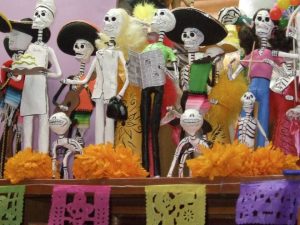
Paula Kollonitz, una de las la damas europeas de la corte de la emperatriz Carlota, escribió el libro “Viaje a México en 1864”, y nos cuenta: “El día de Todos los Santos lo pasamos en México. En cierto modo nos pareció extraño porque se celebra con alegría, con cosas que chocan y ofenden al corazón, con frivolidad, mientras que en todos los países católicos ese día, más especialmente que cualquier otro, se honra a los que quisimos en vida, a los que mucho amamos y nos robó la muerte.
Ya muchos días antes se ponen palos, se alzan tiendas y puestos en la Plaza Mayor que, poco a poco, va llenándose de juegos y confituras. Todo es simbólico, todo recuerda el día de muertos, así es que no se ven mas que pequeños féretros, calaveras, esqueletos, catafalcos y sacerdotes con sus sombreros a la “don Basilio”, como lo usan en el país; largos carros de pompas fúnebres de todas dimensiones y formas: de madera, de azúcar, de cartón, que se ofrecen a los niños para su solaz y para deleite de su paladar. Felices corren las criaturas por las angostas calles que los puestos forman en la plaza y se mira, se goza, se compra. ¡Es un día de fiesta! En todas las casas al caer de la noche se pone una mesa sobre la cual se apoyan catafalcos burlescos y donde se exhiben toda clase de alimentos y de frutas. Los niños y los criados creen que mientras en la casa se duerme, vienen aquí los muertos a sentarse y a banquetearse.
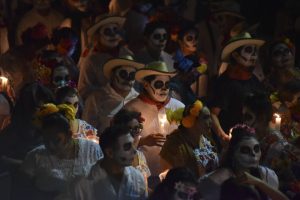
Nuestra relación con la muerte en esta celebración es muy particular. Si bien existen diferencias entre la serenidad ritual con la que la gente del campo recibe a sus muertos, con el jolgorio urbano con el que festejamos el regreso de los nuestros en las ciudades, el elemento común es celebrar con los muertos a través de la comida.
Los altares de esta fiesta incluyen fotos para recordar la presencia física de los muertos. De velas, para alumbrar su camino de regreso al más allá. De agua para aliviar su sed, pues el recorrido desde la eternidad es largo. De flores de cempasúchil fragantes para que los muertos se regocijen con su bálsamo. De objetos personales, para que no se confundan de morada y recuerden sus pertenencias que los acompañaban en vida. De papel picado y de alfeñiques para que juntos nos riamos del fin de la vida, que es el inicio de otra nueva en la memoria de los nuestros. No dejamos de existir del todo, pues el recuerdo de los deudos nos mantiene vivos después de la muerte.
Pero sin duda los alimentos son el elemento más importante de toda la ofrenda. Comenzando por las frutas de temporada que están disponibles al final de la cosecha. Se escogió una fecha llena de abundancia para agasajar a los muertos, y a sus convidados.

Destaca la deliciosa calabaza de Castilla, nombre que no deja de ser un enigma, pues ésta es del todo mesoamericana y no española. Cocida en melcocha de piloncillo dulce de caña y que llamamos “en tacha.” Pero también están las limas aromáticas, las granadas y las jícamas. Así como las frutas regionales perenes, como los plátanos y los cocos de las costas. En otras regiones se suman naranjas, manzanas y uvas, entre muchas otras más.
De los productos de la tierra pasamos a los preparados. Los mas sencillos son los elotes cocidos. Pero el maíz también se prepara en tamales y tortillas. Esta cocina del significado transforma el trabajo de cocinar en ritual.
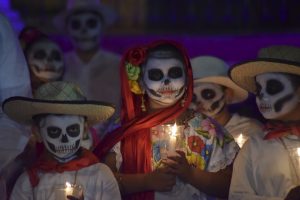
La preparación de una ofrenda de muertos puede incluir tortillas que se echan a mano en el comal. Algunas medianas y delgadas, otras de maíz azul, otras más regordetas y compactas, y las enormes tlayudas oaxaqueñas.
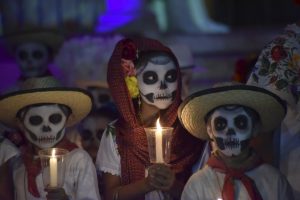
Destacan los deliciosos tamales envueltos a mano por toda la familia, o por un gran equipo de amigos y vecinos que repartirán el fruto de su labor. Uno de los antecedentes prehispánicos de la fiesta de muertos es la fiesta de los tamales en honor a “Xiuhtecuhtli”, dios azteca del fuego. Y en la que nos cuentan los cronistas, se ofrecían cinco tamales a las llamas del hogar, que se colocaban sobre cinco sepulturas. Al terminar la fiesta se comían todos los tamales elaborados para la fiesta sin dejar ni uno solo.
Dejaremos para una siguiente entrega las dos preparaciones más complejas: el mole y el pan de muertos.
Las especialidades gastronómicas del Día de muertos.
En la fecha del Día de muertos se suele preparar mole. La complejidad de su preparación tradicional lo reservaba para las grandes ocasiones. Y sin duda el día de los fieles difuntos era y es, una de ellos, aunque hoy en día lo compremos en pasta ya procesada industrialmente. Es tan delicioso que pensamos que cualquier mexicano muerto, regresaría del más allá tan solo para poder comerlo.
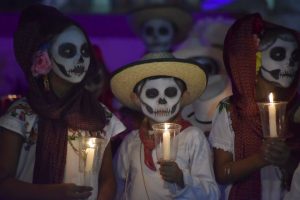
Este platillo, que sin duda podemos considerar nacional, es expresión del fecundo mestizaje culinario que se dio durante el virreinato. Criollos y mestizos eran aficionados a la manera mexicana de cocinar. Esta se caracterizó por incorporar muchos de los ingredientes y recetas oriundas y transformarlos en expresiones amables y españoladas. Las cocineras criollas, en complicidad con sus sirvientas indígenas, encontraron fórmulas para desvenar y despepitar los chiles y evitar así su picor excesivo.
Entre otras cosas, cocían los jitomates en agua hirviendo para hacer caldillos en donde remojar tortillas fritas en manteca para rellenarlas de queso. Machacaban los frijoles y los refreían en grasa animal. Hacían un crujiente y durito chicharrón del cuero del cerdo. Cocían el carnero en horno de tierra para hacer la barbacoa y comerla en tacos de tortilla de maíz con salsa de tomates verdes y chile serrano. Elaboraban pastas dulces de frutas oriundas como la guayaba y el tejocote.
Muchas de estas cocineras eran monjas que hicieron famosas muchas recetas, pues las órdenes religiosas participaban en la vida cotidiana de la Nueva España. Y quienes a pesar de la clausura en que vivían, destacaban con sus recetas, sus obras de teatro y sus obras pías.
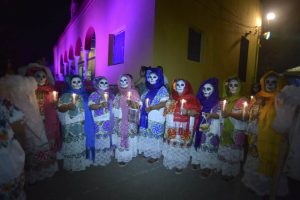
Los conventos eran lugares bien abastecidos de mantenimientos. Sin duda eran laboratorios culinarios en que se contaban con los recursos provenientes de todas las provincias de la Nueva España, y que eran parte del imaginario colectivo con el que sus habitantes se creían elegidos de Dios. En esos tiempos se hablaba de “nuestras floridas y ricas tierras, la nación más opulenta, señora de las riquezas del mundo.” Todo convento femenino de prestigio tenía una bodega abundante de ingredientes provistos por la “Divina Providencia”.
Las distintas órdenes tenían disputas y rivalidades entre ellas. En cada convento tenían sus propias aficiones culinarias: en Santa Rosa fabricaban dulces de camote. En La Concepción elaboraban frutas cristalizadas con baños de melaza. Las Agustinas recoletas preferían bordar pañuelos y manteles. Pero la comida era la especialidad de las Clarisas, que si bien tenían jurado un voto de pobreza, a la hora de elaborar la comida desplegaban una creatividad y fastuosidad únicas. Habían logrado arrebatar la preeminencia que las de Santa Rosa habían tenido décadas atrás en los fogones. Preparaban un delicioso mole dulcificado con chocolate que les llegaba desde Alvarado, y añadían granos de anís, clavo, canela, pimienta gorda, almendras y ajonjolí a la pasta de los chiles secos. Bañaban las piezas de pollo cocido en caldo con laurel y lo acompañaban con arroz cocido y mollejas. Una de sus variantes es el pipian de cacahuates y pepitas con tomatillos, en que las hermanas cocineras rehogaban lomos magros.
Continuando con los altares de muertos, encontramos los panes de muerto y los alfeñiques de azúcar para decorar nuestros altares elaborados pacientemente por las manos del prodigio. Los mexicanos recordamos así, que los dioses lograron figurar al hombre perfecto con masa de maíz, el alimento nuestro.
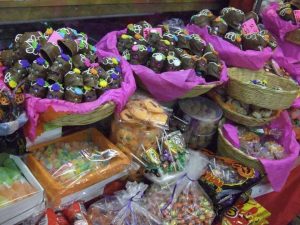
El pan mexicano tiene una historia muy particular. El trigo fue uno de los ingredientes primordiales para la sociedad novohispana. Era el grano para la conquista espiritual de la amplia población indígena.
Pese a la división administrativa en la Nueva España (nombre que se usó para México durante el largo periodo virreinal) en la república de los españoles y la república de los indios, estos últimos tenían contacto permanente con los frailes, quienes se dedicaban a evangelizar a la población indígena. El gusto por el pan se fue afianzando entre ellos poco a poco. Las custodias litúrgicas del alimento divino se comenzaron a sacar en procesión, cargadas por los miembros de las cofradías de indígenas. Para ese entonces se invocó la tradición de la vieja Castilla, en donde la población se beneficiaba de los molinos y los hornos comunitarios. Estos también se construyeron en los conventos durante el siglo XVI y para los frailes la panadería constituía parte del funcionamiento del reino utópico que construían día con día. Tuvieron que pasar muchos años, en los que fueron llegando más inmigrantes españoles, para que se extendiera el cultivo del trigo y sus precios fueran asequibles a las mayorías. Desde esos tiempos de la evangelización, el consumo de pan estuvo asociado, entre los indígenas, a fechas especiales de fiesta del calendario ritual de su nueva religión.
Para los días de reyes, para la semana santa y la de corpus y para el día de los fieles difuntos.
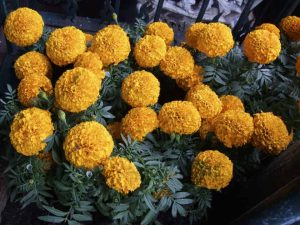
La tradición de dar forma simbólica a los panes es parte del sincretismo cultural entre lo indígena y lo español. Existía una tradición nahua de elaborar con semillas de amaranto la figura de un dios, que se repartía durante la fiesta como alimento sagrado entre todos los convidados. Esta tradición se trasladó al obrador de pan.
Existen panes decorados con esmero con pasta de manteca y azúcar que se elaboran para las fiestas patronales y kermeses, y que contienen leyendas y ornamentos.
Entre todos estos panes resalta el de muertos. En algunas comunidades, la masa del pan cotidiano simplemente se decora con formas de huesos con la misma masa, y se espolvorea con ajonjolí o con azúcar roja. También se hacen con formas de mortaja con un rostro de alfeñique dulce.
En las ciudades, el pan de muertos se hace de masa de bizcocho. Solo que se aromatiza con granos de anís, con raspadura de naranja y limón y con agua de azahares. Sobre la masa boleada se colocan las canillas y la canícula, que asemejan huesos, o bien, que le dan forma de sombrero a la “San Basilio”, ese bonete religioso antiguo.
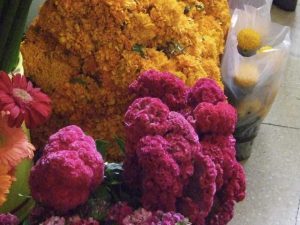
Para revolcarlo en azúcar es necesario barnizarlo con mantequilla o manteca al salir del horno y ya frío. El sabor dulce indica que es un pan de fiesta. Las golosinas eran hace siglos unos de los pocos agasajos que se podían permitir las mayorías. No solo en la cubierta del pan, sino como ingrediente de la masa, y desde luego, como materia prima para hacer dulces con forma de calavera, o pequeños féretros, incluso pequeñas ofrendas de dulce en donde se imitan los componentes del altar: ollas con mole, canastas con tamales, jícaras con chocolate, etc.

Curiosamente existe una similitud de la pasta de todos estos alfeñiques con la pasta garofolata o garofanata per ossa dei morti, que es la pasta para huesos de muertos, que se prepara en Sicilia. En dicha isla mediterránea, también se cree que los muertos regresan el día de todos los santos. Pero a diferencia de nuestro país, en donde nos esmeramos en recibirlos y prepararles su comida, los sicilianos creen que los muertos traen esos dulces en forma de osamenta, y los niños los esperan con gran ansiedad.
La mayoría de los altares incluye algún espirituoso. Como el tequila o el mezcal, pero también cerveza. En el entendido de que cualquier muerto que regresa, quiere disfrutar nuevamente de una copita.
Lo especial de los altares de muertos, es que siempre se cocina de más, y se coloca una copiosa cantidad de alimentos que comparten todos en familia. A través de los alimentos vencemos el abismo de la muerte y recuperamos el contacto con nuestros afectos ya pasados. La cena del día de muertos es un momento de comunión con nuestro origen más próximo, el de nuestra familia y nuestros amigos y conocidos ya fallecidos. Y que sabemos que nos esperan en algún lugar cerca del sol, cuando nos llegue nuestra hora.
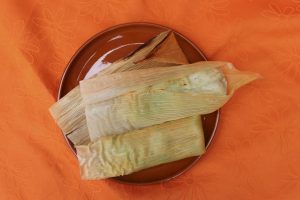

The altars of the dead

Every November 2nd, we Mexicans prepare a banquet for the dead who visit us. Thus we revive the mystical expression of the kitchen when preparing the sacred foods, which we will share with our ancestors and with our gathered community. We place the offerings on their traditional altars and they are the bread of the dead, tamales, mole (a sauce made from chocolate and dried chilies) and the seasonal pumpkin in sweet and chocolate shake.

This tradition is very important to Mexicans as well as the bridge that unites us with our ancestors, and with our loved ones who have departed. It is a party with unique characteristics that amaze foreigners.
Paula Kollonitz, one of the European ladies of Empress Carlota’s court, wrote the book “Journey to Mexico in 1864”, and tells us: “We spent All Saints’ Day in Mexico. In a certain way, it seemed strange to us because it is celebrated with joy, with things that shock and offend the heart, with frivolity, while in all Catholic countries, that day, more especially than any other, honours those we loved in life, those we love so much and were stolen from us.
Many days before, sticks are put up, and shops and stalls are set up in the Plaza Mayor which, little by little, is filling up with games and preserves. Everything is symbolic, everything reminds you of the day of the dead, so you can only see small coffins, skulls, skeletons, catafalques and priests with their “don Basilio” hats, as they wear in the country; long hearses of all shapes and sizes: wooden, sugar, cardboard, offered to children for their solace and to delight their palates. Happy the creatures run through the narrow streets that the stalls form in the Plaza. It’s a holiday! In all the houses at nightfall, a table is placed on which burlesque catafalques are supported and where all kinds of food and fruit are exhibited. The children and the servants believe that while the house sleeps, the dead come here to sit and feast.
Our relationship with death in this celebration is very particular. Although there are differences between the ritual’s serenity with which country people receive their dead and the urban revelry with which we celebrate the return of our loved ones in the cities. The common element is celebrating with the dead through food…
The altars of this festival include photos to remember the physical presence of the dead, candles, to light your way back to the afterlife,

water to alleviate your thirst, since the journey from eternity is long, fragrant cempasúchil flowers so that the dead can rejoice with their balm, personal objects so that they do not confuse their home and remember the belongings that accompanied them in life, confetti and weaklings so that together we can laugh at the end of life, which is the beginning of a new one; the memory of our loved ones. We do not cease to exist completely, because the memory of our relatives keeps us alive after death.
Without a doubt, food is the most important element of the entire offering. Starting with the seasonal fruits that are available at the end of the harvest. A date full of abundance was chosen to entertain the dead, and their guests.
The delicious pumpkin from Castilla stands out as a name that is still an enigma since it is completely Mesoamerican and not Spanish. It is Cooked in sweet cane piloncillo taffy that we call “en tacha”. There are also aromatic limes, pomegranates and jicamas as well as perennial regional fruits, such as bananas and coconuts from the coasts. In other regions, oranges, apples and grapes are added, among many others.

From the products of the land, we go to the preparations. The simplest is cooked corn. But corn is also prepared in tamales and tortillas. The meaning of the preparations transforms the work of cooking into a ritual.
The preparation of an offering for the dead can include tortillas that are thrown by hand on the comal. Some are medium and thin, others made of blue corn, others more plump and compact and the enormous Oaxacan tlayudas.

The delicious tamales are wrapped by hand by the whole family, or by a great team of friends and neighbours who will distribute the fruit of their labour. One of the pre-Hispanic antecedents of the festival of the dead is the festival of tamales in honour of “Xiuhtecuhtli”, the Aztec god of fire. One chronicler tells us that five tamales were offered to the llamas of the hearth, which were placed on five graves. At the end of the party, they ate all the tamales made for the party without leaving a single one.
We will leave for the next installment, the two most complex preparations: the mole and the bread of the dead.
The gastronomic specialties of the Day of the Dead

On the date of the Day of the Dead, a mole is usually prepared. The complexity of its traditional preparation reserves it for great occasions. Without a doubt, the day of the faithful departed was and is one of them, although today we buy it in already industrially processed pasta. It is so delicious that we think that any dead Mexican would return from the afterlife just to be able to eat it.
This dish, which we can undoubtedly consider national, is an expression of the fertile culinary mix that took place during the viceroyalty. Criollos and mestizos were fond of the Mexican way of cooking. This was characterized by incorporating many of the native ingredients and recipes and transforming them into friendly Spanish expressions. Creole cooks, in complicity with their indigenous servants, found formulas to devein and seed the chiles and thus avoid their excessive heat.
Among other things, they cooked tomatoes in boiling water to make soups in which they soaked tortillas fried in butter and fill them with cheese. They pounded the beans and fried them in animal fat. They made a crispy, hard pork rind from the skin of the pig. They cooked the ram in a dirt oven to make a barbecue and eat it in corn tortilla tacos with green tomato sauce and serrano chile. They made sweet pastes from native fruits such as guava and hawthorn.

Many of these cooks were nuns who made many recipes famous since the religious orders participated in the daily life of New Spain. Despite the closure in which they lived, they stood out with their recipes, their plays and their pious works.
The convents were places well supplied and maintained. Undoubtedly, they were culinary laboratories that had resources from all the provinces of New Spain and were part of the collective imagination with which its inhabitants believed they were chosen by God. In those times, there were talks of “our flowery and rich lands, the most opulent nation, mistress of the riches of the world.” Every prestigious women’s convent had an abundant store of ingredients provided by “Divine Providence.”
The different orders had disputes and rivalries between them. In each convent they had their own culinary hobbies: in Santa Rosa they made sweet potato candies. In La Concepción they made crystallized fruits with molasses baths. The Augustinian Recollects preferred to embroider handkerchiefs and tablecloths. But food was the specialty of the Poor Clares, who, although sworn a vow of poverty, displayed unique creativity and magnificence when preparing food. They had managed to snatch the preeminence that those of Santa Rosa had had decades ago in the kitchen. They prepared a delicious mole sweetened with chocolate that came from Alvarado, and added grains of anise, cloves, cinnamon, allspice, almonds, and sesame seeds to the dried chile paste. They bathed the pieces of cooked chicken in broth with bay leaf and accompanied it with cooked rice and sweetbreads. One of its variants is the pipian of peanuts and seeds with tomatillos, in which the cook sisters braised lean loins.
Continuing with the altars for the dead, we find the bread of the dead and sugar alfeñiques to decorate our altars, patiently made by the hands of the prodigy. We Mexicans remember that the gods managed to figure out the perfect man with corn dough, our food.
Mexican bread has a very particular history. Wheat was one of the essential ingredients for New Spain society. It was the grain for the spiritual conquest of the vast indigenous population.

Despite the administrative division in New Spain (the name used for Mexico during the long viceregal period) into the Republic of the Spanish and the Republic of the Indians, the latter had permanent contact with the friars, who dedicated themselves to evangelizing the indigenous population. Little by little, the taste of bread took hold between them. The liturgical monstrances of divine food began to be taken out in procession, carried by the members of the indigenous brotherhoods. At that time, the tradition of old Castile was invoked, where the population benefited from the mills and community ovens. These were also built in the convents during the 16th century and for the friars, the bakery was part of the operation of the utopian kingdom that they built on a daily basis. Many years had to pass, in which more Spanish immigrants were arriving, for the cultivation of wheat to spread and its prices to be affordable to the majority. From those times of evangelization, the consumption of bread was associated, among the indigenous people, with special festival dates of the ritual calendar of their new religion; the days of kings, holy week and corpus and the day of the faithful departed.
The tradition of giving the bread a symbolic shape is part of the cultural syncretism between the indigenous and the Spanish. There was a Nahua tradition of making the figure of a god with amaranth seeds, which was distributed during the festival as sacred food among all the guests. This tradition was transferred to the bread maker.
There is bread carefully decorated with butter and sugar paste that is made for patron saint festivities and fairs, and that contains legends and ornaments.
Among all these bread, the one for the dead stands out. In some communities, the dough for everyday bread is simply decorated with bone shapes made from the same dough and sprinkled with sesame seeds or red sugar. They are also made in the form of a shroud with a sweet weakling face.
In the cities, the bread of the dead is made from biscuit dough. It is flavoured with anise grains, orange and lemon zest and orange

blossom water. On the rounded dough, the quills and the heatwave are placed, which resemble bones, which give the shape of a hat to the “San Basilio”, that ancient religious bonnet. To roll it in sugar, it is necessary to varnish it with butter or lard when it comes out of the oven and when it is cold. The sweet taste indicates that it is party bread. Sweets were centuries ago one of the few treats that majorities could afford. Not only in the bread cover, but as an ingredient in the dough, and of course, as raw material to make sweets in the shape of a skull, or small coffins, even small sweet offerings where the components of the altar and imitated: pots with mole, baskets with tamales, gourds with chocolate, etc.
Curiously, there is a similarity between the pasta of all these alfeñiques and the pasta garofolata or garofanata per ossa dei morti, which is pasta for the bones of the dead and prepared in Sicily. On this Mediterranean island, it is also believed that the dead return on All Saints’ Day. Unlike in our country, where we take great care to receive them and prepare their food, the Sicilians believe that the dead bring these sweets in the form of bones, and the children wait for them with great anxiety.
Most of the altars include alcohol like tequila, mezcal or beer. It is assumed that any dead person who returns wants to enjoy a drink

again.
The special thing about the altars for the dead is that they always overcook, and a copious amount of food is shared by the whole family. Through food, we overcome the abyss of death and recover contact with our past affections. The Day of the Dead dinner is a moment of communion with our closest origin, our family, our deceased friends and acquaintances. We know that they are waiting for us somewhere near the sun when our time comes.

Récents articles
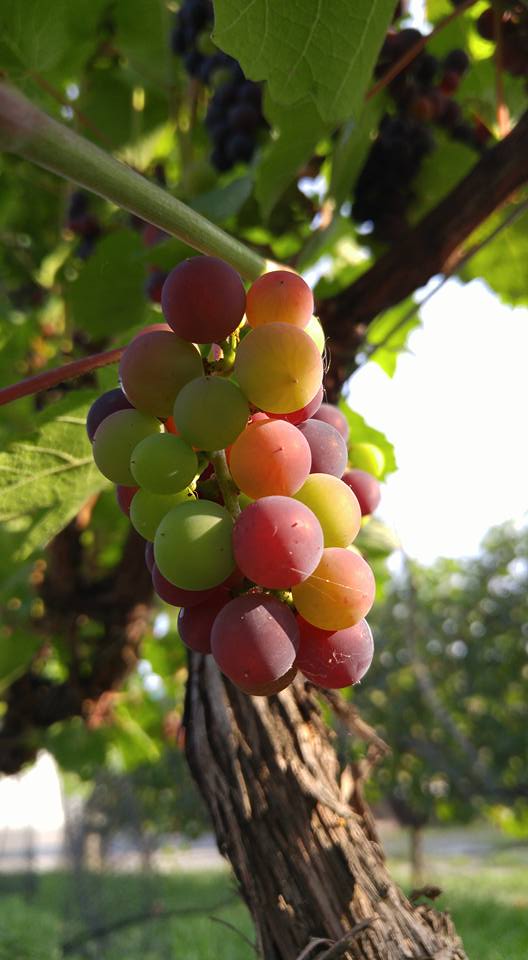
Stay tuned for new articles and industry trends !
Subscribe to our newsletter and make sure you don’t miss the publication new editions of the magazine!

